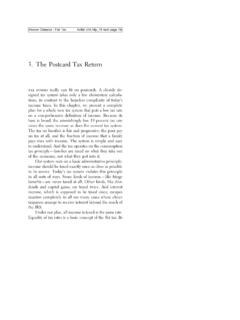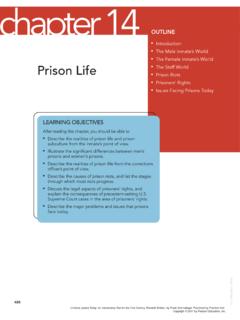Transcription of Bankruptcy Code Chapter 14: a) Define Financial ...
1 1 2/28/12 Bankruptcy Code Chapter 14: A Proposal Contents Introduction I. Creation of a New Chapter 14 a) Define Financial Institution b) Create Chapter 14 c) Assign Chapter 14 Cases and Proceedings to Designated Art III District Judges II. Commencing a Chapter 14 Case a) Allow the Entire Covered Financial Institution (Including Subsidiaries) to be Resolved in Bankruptcy b) Give the Primary Regulator the Power to File an Involuntary Petition c) Allow the Primary Regulator to File Based on Balance Sheet Insolvency III. Role of the Primary Regulator in Chapter 14; DIP Funding a) Regulator Standing b) Motions for the Use, Sale, or Lease of Property c) Debtor in Possession (DIP) Financing d) Filing Plans of Reorganization IV. Qualified Financial Contacts in Chapter 14 Introduction a) Repos and the Automatic Stay b) Derivatives/Swaps and the Automatic Stay c) Repos, Derivatives/Swaps and Trustee Avoiding Powers Summary of Proposed Revisions 2 Introduction This paper describes several proposed changes to the Bankruptcy Code that are designed for and limited to the reorganization or liquidation of the nation s largest Financial institutions.
2 The proposed changes create a new Chapter 14 of the Bankruptcy Code and incorporate features of liquidations under Chapter 7 as well as reorganizations under Chapter 11. In addition, the proposed Chapter 14 contains a number of substantive and procedural changes designed especially for the complexity, and potential systemic consequences, of the failure of these large Financial institutions. Through these changes, we believe it is possible to take advantage of a judicial proceeding including explicit rules, designated in advance and honed through published judicial precedent, with appeals challenging the application of those rules, public proceedings, and transparency in such a way as to minimize the felt necessity to use the alternative government agency resolution process recently enacted as a part of the Dodd Frank Wall Street Reform and Consumer Protection Act. The new Chapter could be adopted either in addition or as an alternative to the new resolution regime of Dodd Frank.
3 The crucial feature of this new Chapter 14 is to ensure that the covered Financial institutions, creditors dealing with them, and other market participants, know in advance, in a clear and predictable way, how losses will be allocated if the institution fails. If the creditors of a failed Financial institution are protected (bailed out), then the strongest and most rapidly-responding constraint on risk-taking by the Financial institution s management is destroyed, and their losses are transferred to others. 3 In the following sections, we explain the features of this new Chapter 14 by (a) outlining existing Bankruptcy provisions that we propose to amend or replace, (b) summarizing perceived weaknesses in those provisions that this proposal addresses, and (c) outlining the nature of the statutory provisions that are designed to address these weaknesses. These statutory changes can be encompassed within four basic categories: (1) the creation of a new Chapter 14; (2) the commencement of a Chapter 14 case, (3) the role of the primary regulator in Chapter 14 and special rules regarding debtor-in-possession financing for purposes of prepayments to certain creditors, and (4) the treatment of qualified Financial contracts in Chapter 14.
4 Following that, we provide, in summary form, a list of the changes we propose and the likely place in either the Bankruptcy Code or in Title 28 (the jurisdictional title) to make those changes. I. Creation of a New Chapter 14 a. Define Financial Institution Current Law There is no special definition of a Financial institution. Concerns Bankruptcy seems to be undervalued as a potential solution to the liquidation or reorganization of complex Financial institutions, including in the 2010 Congressional debate over Financial reform, in part because of a view that the default of one or more of 4 the nation s largest and most complex Financial institutions is (a) outside the competence of the Bankruptcy system, (b) unable to be resolved in a timely fashion in a judicial proceeding, and (c) likely to have systemic consequences that an adversarial system, which depends on parties-in-interest with standing before the court, is ill-equipped to respond to. Proposal In order to craft a Bankruptcy process that is responsive to the special needs of the nation s largest Financial institutions, it is necessary to create a special set of procedures and rules for such Financial institutions.
5 This starts, most fundamentally, with a need to provide, in the Bankruptcy Code, a definition of the Financial institutions that would be covered by these special procedures and rules. Because many of the concerns focus on the nation s largest institutions, with no strong sense that existing procedures are insufficient for other Financial institutions, the definition should not only Define what is a Financial institution but it should also set a threshold for the size of the institution before invoking the special rules and procedures we propose. The definition we propose would Define a Financial institution for Bankruptcy (and hence Chapter 14) purposes as an institution1 1 The Bankruptcy Code would use the word person, which is defined in 101(41) as including an individual, partnership, and corporation. For convenience, this paper will often use the word institution. that is substantially engaged in providing Financial services or Financial products, and includes any subsidiaries of any such institution.
6 To eliminate purely local Financial institutions, the definition would 5 include a minimum asset size of $100 billion for the combined enterprise a figure that should have a mechanism for adjustment with changes in the Financial b. Create Chapter 14 Current Law No such Chapter exists. Concern Because of the special procedural and substantive rules that are perceived to be needed to make Bankruptcy a robust alternative to government agency resolution for the nation s largest Financial institutions, there needs to be a mechanism, within the Bankruptcy Code, for (a) incorporating the vast majority of common Bankruptcy Code provisions in Chapters 1 (general provisions), 3 (case administration and administrative powers [such as the automatic stay, the use,sale, or lease of property, obtaining credit, and the treatment of executory contracts]), and 5 (determining assets and claims, priorities, and provisions such as set-offs, and the recovery of preferences and fraudulent conveyances), as well as the outcome Chapters 7 (liquidation) and 11 (reorganization), while (b) ensuring that those special procedural and substantive rules for covered Financial institutions govern and amend or override certain common Bankruptcy Code provisions.
7 2 Unlike Title II of Dodd-Frank, where a covered Financial company can be determined after-the-fact (the category includes both firms that derive 85 percent of their revenues from activities that are Financial in nature as well as any Financial company designated as systemically important through an elaborate executive branch determination regarding systemic consequences), we propose using a pre-determined size threshold, so as to remove uncertainty in terms of whether a particular institution (on either a voluntary or involuntary petition) is appropriate for our proposed Chapter 14. 6 Proposal In essence, our proposal provides a new Bankruptcy process (including certain new substantive rules) for Financial institutions for the liquidation or reorganization of these defined Financial institutions. At the same time, the Bankruptcy Code s structure and rules for a liquidation proceeding, in Chapter 7, and for a reorganization proceeding, in Chapter 11, provide a solid starting place, with a wealth of important judicial gloss on statutory terminology, that would be usefully applied in many situations involving a covered Financial institution.
8 To accomplish both goals simultaneously, we propose that the proceeding (or case ) when a covered Financial institution invokes (or is placed in) Bankruptcy follow the rules of the existing Bankruptcy Code except where we propose to change those rules. Particularly because our proposal envisions a different judicial path, as we describe below (involving district judges in lieu of Bankruptcy judges), to use the existing Bankruptcy Code structure, and attempt to amend various provisions in Chapter 7 and 11 to accommodate our proposal, would be cumbersome. Thus, our proposal is to create a new Chapter 14 in the Bankruptcy Code and require covered Financial institutions to concurrently file for Chapter 14 and Chapter 7 or Chapter 11 (that is, covered Financial institutions cannot file for Chapter 7 or Chapter 11 without also filing for Chapter 14), and requiring the resulting liquidation ( Chapter 7) or reorganization ( Chapter 11) proceeding to be conducted according to the rules, and under the special court supervision, of Chapter 14.
9 7 The essence, then, of this change would be to insert a new subsection into 1093 c. Assign Chapter 14 Cases and Proceedings to Designated Article III District Judges that (a) limits Chapter 14 to Financial institutions (as defined), (b) provides that a Financial institution may not be a debtor under Chapter 7 or Chapter 11 without first (or concurrently) commencing a case under Chapter 14, and (c) provides that all proceedings under this simultaneous Chapter 7 or Chapter 11 shall be conducted pursuant to the provisions of Chapter 14. Current Law (i) Judges. Because Bankruptcy judges are not Article III judges (primarily because they do not enjoy life-time tenure, which is a constitutional requirement for Article III judges), the Supreme Court, in Northern Pipeline Constr. Co. v. Marathon Pipe Line Co. 458 50 (1982), struck down certain features of the original jurisdictional grant in the Bankruptcy Code of 1978 to Bankruptcy judges to hear and decide various cases and controversies that arise in connection with a Bankruptcy proceeding.
10 In response to Northern Pipeline, Congress enacted the current jurisdictional structure in 28 157. It provides that Bankruptcy cases are filed in the district court (comprised of Article III judges), but that a district court may provide (as all have) that cases under title 11 [the Bankruptcy Code] and proceedings arising under title 11, shall be referred to the Bankruptcy judges for the district. Those judges may then hear cases under title 11 and core proceedings arising under 3 All section numbers, unless explicitly indicated otherwise, refer to Title 11, US Code. 8 title 11, with 28 157(b)(2) attempting to Define core proceedings in a way that is consistent with what the Supreme Court, in Northern Pipeline, said that non-Article III judges could hear and determine. Things that are not core proceedings, but are otherwise related to a Bankruptcy case, can be heard by a Bankruptcy judge, but that judge can only submit proposed findings of fact and conclusions of law to the district court, and the district court must issue any final order or judgment, 28 157(c)(1).










